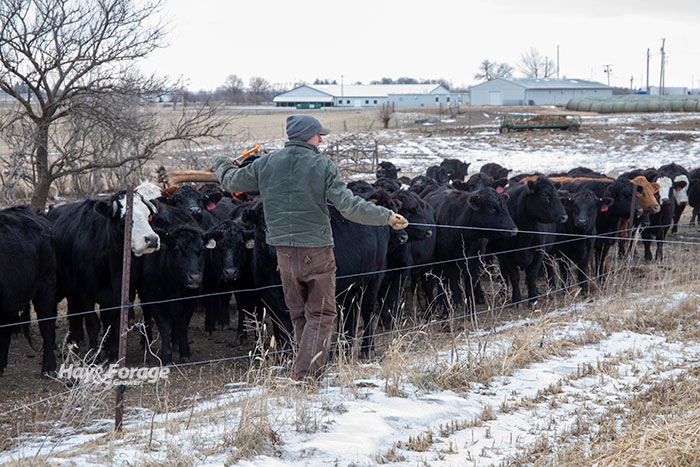
While cold weather and Christmas shopping might not be top of mind, it is time to think about winter feeding strategies and inventory. Preplanning to maximize utilization rates and extend the grazing season could help to combat current high feed costs and fuel prices.
Depending on location, producers have many options for winter feeding. Denise Schwab with Iowa State University suggests that with proper planning, winter grazing can even be successful in regions with cold and snowy conditions. The extension beef specialist offers this advice for those who have a long underwear dresser drawer.
Stockpile. Allocate an area of a pasture to stockpile in August and wait to graze it until after the first killing frost. Tall fescue tends to stockpile well because it continues to stand upright after it freezes, but other cool-season species can be stockpiled as well.
Summer annuals like sudangrass, sorghum-sudangrass, and millet can also be stockpiled; however, sudangrass and sorghum-sudangrass come with the risk of prussic acid poisoning in livestock. Do not graze these species for at least one week after a killing frost. Then, strip-graze the forage with an electric fence, advancing the polywire every couple of days.
“Iowa research shows we can grow 3 to 5 tons of dry matter per acre from summer annuals, which should provide about 80 to 130 cow grazing days per acre at 50% utilization rate,” Schwab states.
If pasture acres are limited, consider stockpiling a hayfield. In this case, skip the last hay cutting to ensure an adequate amount of forage. Graze alfalfa within seven to 10 days of a killing frost to capture forage quality and minimize bloat risk.
Seed winter annuals. Some winter annuals can prolong fall grazing, whereas others initiate spring grazing. Drill oats, triticale, and/or brassicas after corn silage harvest or early soybean harvest to graze later this season. Winter cereal rye, on the other hand, will provide the most growth in the spring.
Bale graze. For the best utilization rates, distribute bales throughout a field and use temporary fences to allot enough forage for one to two days. Doing so will also spread manure across the field more evenly than feeding bales in a designated feeding area.
Graze cornstalks or standing corn. “Cornstalk grazing has been a major feed source across Iowa for early winter feed, but we only utilize less than a quarter of the stalks available in the state,” Schwab says. “The nutrition in the stalks is highest in the ears, leaves, and husks, and once these are consumed or deteriorated by weather, the feed value drops rapidly.”
To prevent this, implement rotational or strip grazing. Schwab recommends starting larger herds in fields harvested first and rotating them to new land when ears, leaves, and husks have been consumed. For smaller herds, use electric fences to strip graze crop residue and move animals to a new area every week or two.
Standing corn can also be grazed, but this method may be harder to justify given high grain prices. Nonetheless, harvest some corn before grazing to ensure a better ratio of grain to forage and to reduce how much grain is left in the field.
Swath graze. Although swath grazing is more common in Canada, university researchers conducted a study to assess the efficacy of this practice in Iowa. They stockpiled a field of sorghum-sudangrass after its second cutting, and then mowed and windrowed the forage in late December.
“Cows stayed on the swaths through mid-February with no negative consequences from snow or ice,” Schwab notes. “Strip grazing the swaths resulted in 70% utilization of the forage available, so very little residue was left in the field for the next crop, and no additional tillage was needed to remove the residue,” she adds.
Swath grazing cornstalks is another option, but Schwab says this may be a more difficult approach. “Shut off the chaff spreader on your combine to create a swath of leaves and husks following grain harvest, then strip-graze in January where you can supplement with additional feed if needed,” she instructs. “Just be sure your grazing density on the strips is intense enough to utilize all the forage in the windrow and not to leave too much behind for spring planting season.”

Amber Friedrichsen served as the 2021 and 2022 Hay & Forage Grower summer editorial intern. She currently attends Iowa State University where she is majoring in agricultural communications and agronomy.

